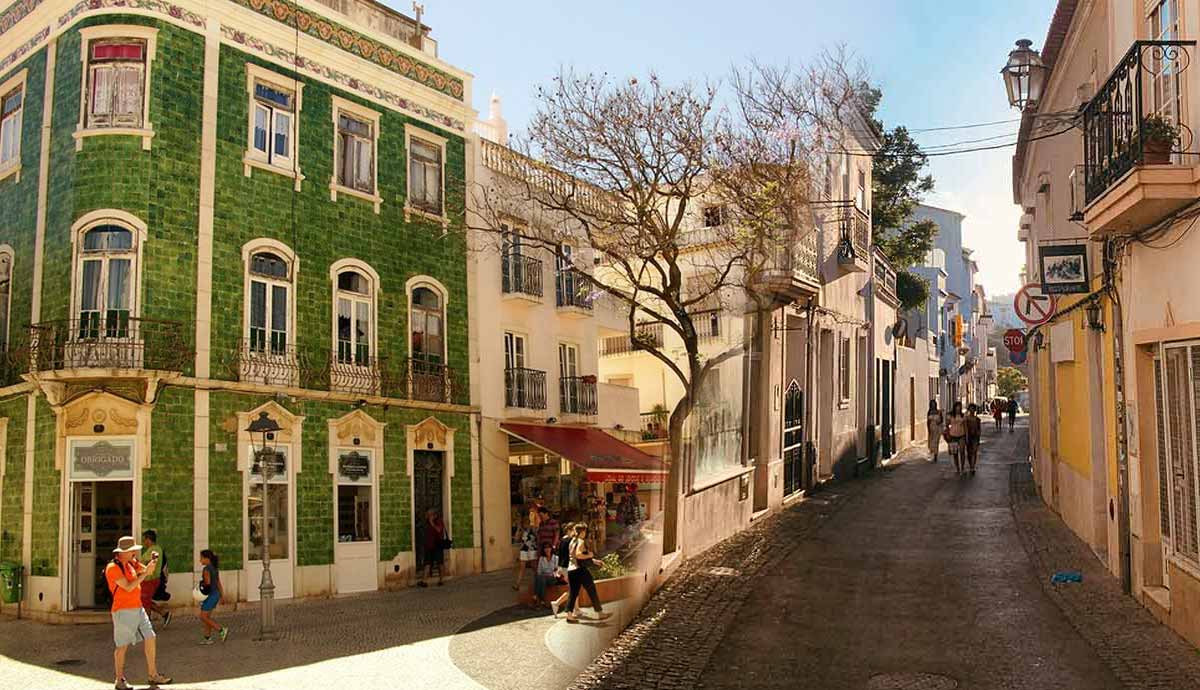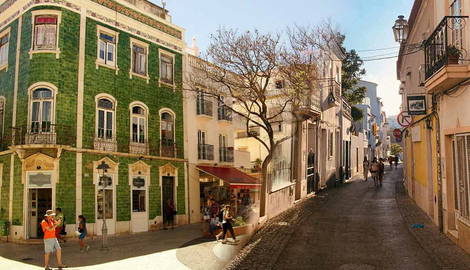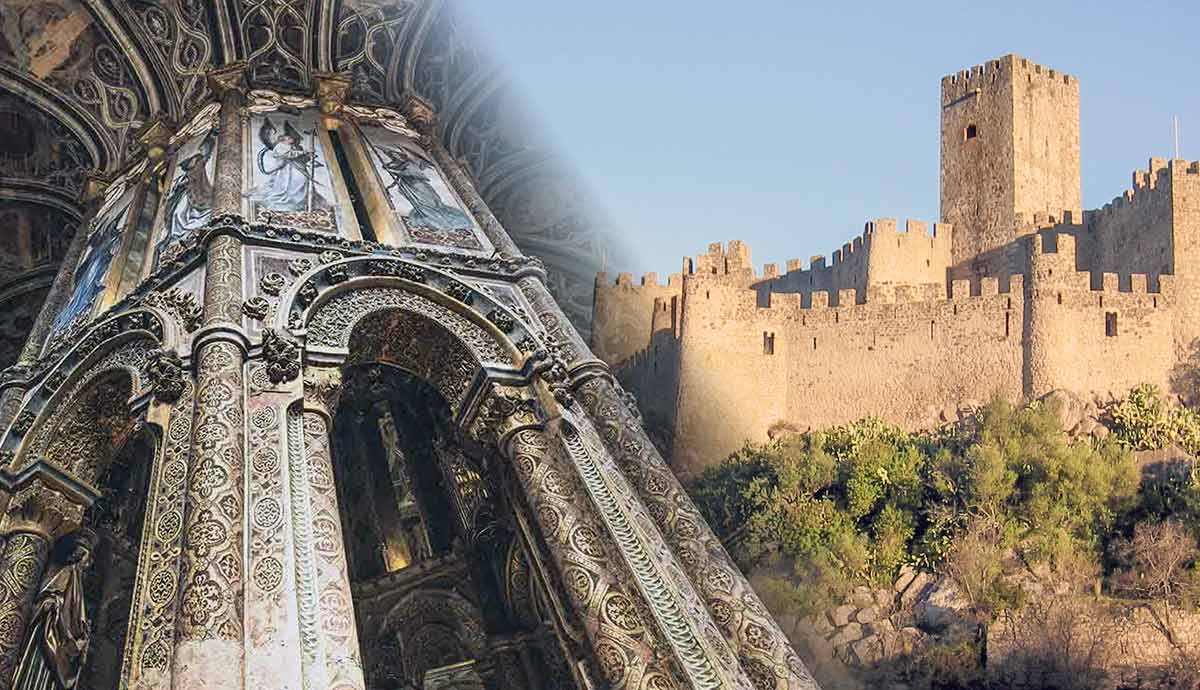
Lagos, Portugal is a 4,000-year-old coastal city that was once home to the Carthaginians, the Romans, and the Moors. After the Reconquista, Lagos played a pivotal role in the Portuguese maritime expansion.
In 1755, Lagos lost its influence after the devastating earthquake and tsunami. Although the city recovered, it never regained the power it had in the Middle Ages.
In the 19th and early 20th centuries, Lagos’s canning industry boomed, and after the Second World War, tourism became the main economic activity. Today, Lagos is a charming Algarvian coastal town with an incredible past worth unraveling.
The First Settlers and the City’s Foundation

The first traces of human occupation in Lagos and its surroundings date back to the Neolithic. Archaeologists have found fishing hooks and sewing tools made of deer antlers in caves and in a small settlement of Monte Molião, dating back to around 4500 BCE.
During this period, fishing boats were made of leather with thin wooden masts to avoid wind damage. Tuna and sardines caught in Lagos were salted and exported to Northern Africa. This high-quality fish even reached ancient Greece during the time of Hippocrates.
Before the Roman occupation, the Iberian people inhabited the Iberian Peninsula and Lagos. However, with the Celtic invasion in the 4th century BCE, Iberians and Celts mixed to form the Celtiberians.
Some historians believe the city’s foundation can be traced to its Celtic origins. However, the most accepted theory is that Lagos was founded in 1899 BCE by Hispanic King Brigo, who founded several fortified cities in its territory. Lacobriga derives from the king’s name and the lakes surrounding the settlement.
Phoenicians, Carthaginians, and Romans

Phoenicians arrived in the Lagos region around 935 BCE, looking for gold and silver. As a result, their contact with the locals wasn’t always friendly, leading them to seek help from their Carthaginian allies. Several Phoenician artifacts found in excavations in Lagos and its surroundings, and dating to the 8th and 7th centuries BCE, prove their presence.
During Carthaginian rule, Lagos became a prominent city due to fishing and agricultural production, coral capture, and a large bay that sheltered ships from the northern winds. Nevertheless, the Celtiberian people in the Iberian Peninsula here weren’t happy with their Carthaginian rulers and asked the Romans for help. This led to the famous Punic Wars that lasted for over 40 years.
In 76 BCE, the Romans laid siege to Lacobriga, hoping the city would surrender due to a water shortage. Instead, the Lusitanian resistant leader Sertório, and 2,000 Lusitanian and African knights defeated the Romans, ended the siege, and brought water to the city. After Sertório’s assassination, Lacobriga fell to the Roman Empire.
Under Roman rule, Lacobriga established itself as an important industrial hub. Some evidence of the city’s importance includes a complex of salting plants and a rubbish dump for a ceramics factory.
Lagos in the Middle Ages

When the Roman Empire showed signs of weakness, the Alans, Vandals, and Suevi invaded the Iberian Peninsula and divided the territory among themselves. The Romans feared the empire would collapse and asked the Visigoths for help.
The Visigothic monarchy eventually took over the Iberian Peninsula and ruled for another 300 years. In 622, Lagos was the seat of a bishopric, whose bishop took part in a Council of Toledo. Visigothic rule in Iberia ended with the Moorish arrival.
The fearless Northern African warriors, commanded by General Tariq, crossed Gibraltar Strait in 711 and reached Lagos in 716. The Moorish occupation was the longest in the history of the Iberian Peninsula and left deep marks on our culture, architecture, language, and gastronomy.
Under Moorish rule, Lacobriga became known as Al-Zawaia, which means “Muslim Monastery,” lake, or well. Although historians believe the city castle was built during this period, the truth is that Lagos’s influence declined over the years, transforming this prominent city into a small fishing village.

In 1189, the Portuguese King Sancho I, accompanied by German and Danish Crusaders, conquered several cities in the Algarve, including Lagos. However, Lagos fell into Moorish hands again in 1191, and only in 1249 it was definitively reconquered by the Portuguese.
Even though the Moors destroyed most of the city to keep the Portuguese from using any of its infrastructures, Lagos was swiftly repopulated by Christian fishermen. Once the Moors were expelled from the Algarve, land battles there ended. However, the Moors continued to attack Christian ships, capture cattle, and kidnap people who they sold as slaves. As a result, to protect the city King Afonso IV ordered the construction of the city walls.
Throughout the 14th century, kings reinforced the importance of fishing activities in Lagos. As a result, tuna and sardine fishing, coral capture, and whale hunting helped the village grow. During this period, new churches were built, such as Igreja de São Sebastião and a church dedicated to Santa Maria da Graça which was destroyed in the 1755 earthquake.
During the reigns of King Ferdinand and King João I, the population inside the town numbered around 1,500 to 2,000 people from the upper social classes. On the other hand, merchants, seafarers, and common people lived in houses outside the city walls, as they were forbidden to live inside them.
The Portuguese Age of Discovery

The 15th century left deep marks on Portugal’s history. Additionally, it brought profound changes to the whole world. Due to its privileged location, Lagos played a pivotal role in the early years of the Portuguese Age of Discovery. It was one of the kingdom’s main ports and the starting point for several naval expeditions in the 15th and 16th centuries.
In 1419, Prince Henry the Navigator left court and settled in Sagres, a small fishing village 30 kilometers (18-19 miles) from Lagos. This was where Prince Henry made the first plans for Portugal’s future overseas expansion. In the same year, native Lagos sailors discovered Madeira Island.
Under Prince Henry’s orders, the navigator Gil Eanes, born and raised in Lagos, crossed Cape Bojador in 1434. At the time, this was a considerable achievement in exploring the African coastline.

In 1441, two expeditions to Africa led by Nuno Tristão and Antão Gonçalves brought some of the first African slaves to Europe. Later, in 1444, Companhia de Lagos was established to carry out commercial operations along the African coast. In the same year, Prince Henry the Navigator organized a fleet of six caravels for an expedition to the Gulf of Arguim, where hundreds of slaves were captured. Due to the constant arrival of new slaves, Lagos built the first slave market in Europe.
Throughout the 15th and 16th centuries, Lagos saw the departure of several expeditions to Africa. With the constant movement of ships and sailors, the village grew. In 1504, King Manuel granted Lagos a charter, offering privileges to its inhabitants and merchants. Some of them included the reduction and exemption of taxes on fishing and shipbuilding and regulated taxes on the purchase and sale of boats. They concentrated the entire salt trade in the crown, prohibiting private individuals from selling salt and opening salt pans.
During King Manuel’s reign, Lagos had developed beyond its original walls. Due to this, the king ordered the construction of new walls, with four bastions by the sea and eight on the land side. The king’s intention was to defend Lagos from Moorish attacks.
In 1573, the infamous King Sebastião elevated Lagos to city status and made it the seat of the bishopric and capital of the Algarve. In the years that followed, King Sebastião was in Lagos to visit the new defensive walls and pray in São Sebastião Church before leaving for Alcacer Quibir Battle, where he disappeared.
Lagos Downfall

Since King Sebastião did not marry or have any children before his disappearance, the Portuguese throne was left to his uncle, who also died without any heirs. As a result, King Phillip II of Spain took over the Portuguese throne, and Portugal lost its independence.
Although the country lost its influence and Portuguese cities became mere villages, Lagos benefited from several fortresses built to defend the city from English privateers such as Sir Francis Drake.
With the Independence Restoration in 1640, Lagos fell into decay. The collapse of agricultural production, reduction of commercial activities, and a cholera epidemic led to Lagos’s downfall.
Beyond that, since the creation of Companhia Geral do Comércio do Brasil, overseas trade concentrated in Lisbon instead of smaller harbors along the Portuguese coastline. Lagos was one of the port cities highly affected by this change since it lost a significant portion of its income.
In the following decades after the Restoration War against the Spanish, the Algarve faced financial crisis and hunger, which worsened until the end of the 17th century. However, the worst was yet to come.
On the morning of November 1, 1755, a massive earthquake hit Southern Portugal and North Africa. With its epicenter at sea, the intense quake was followed by a 65-foot tsunami, which was felt across the Atlantic. This was the most devastating natural catastrophe ever recorded in Portugal.

Inevitably, the coastline between Lisbon and the Algarve was hit. In Lagos, more than 200 people out of 3,000 inhabitants died during the earthquake and tsunami, and many more died soon after. In the aftermath, one of the most prominent figures in the region was Antão Bravo de Sousa Castello, the coroner of Lagos, who ordered the rescue of the people who were still buried under the debris.
A few months later, in February 1756, the town council asked the government for help, reporting that all the structures in Lagos had been destroyed. Besides that, the city needed to rebuild the bridge to allow the delivery of first-need supplies.
The city council also implemented several measures to minimize the impact of the earthquake, such as banning livestock exports, price controls on building materials and food, and fixed workers’ wages. Nevertheless, due to the city’s destruction, all commercial and administrative powers were transferred to Faro.
Lagos’s reconstruction lasted more than half a century. The commercial, military, and administrative power Lagos had gained during the Age of Discovery was irretrievably lost.
Charming Lagos Today

From the second half of the 18th century until the early 20th century, Lagos became an irrelevant small fishing village hit by a series of unfortunate events. Apart from the occasional naval battles and other land conflicts, people had little motive to come and stay in Lagos.
Global events such as the First and Second World Wars highly impacted Lagos’s economy. During this period, this was a city dominated by industry. A large workforce, a direct connection to the inland Algarve, where raw materials and workers came from, and a port to ship products, helped put Lagos on the map.
Of all the industries in Lagos, canned fish was the most impactful. Besides canning factories, other industrial products included cans for canning, wicker baskets, and olive oil. Industry peaked in 1920, with 32 companies operating in Lagos that year.
As the local economy boomed, Lagos built its train station, the National Road 125, and installed electricity in the city. In the 1920s, the first tourists arrived by train and stayed in private homes and campsites.
After the Second World War, Lagos’s industries faced competition from foreign products and relocation to North Africa. Besides that, there was also a decline in fishing, which impacted the canning industry and led to its decay.
As a result, the economy declined and was only revived in the 1980s and 1990s due to the tourist industry. Although tourism had been known in the city since the beginning of the 20th century, it was the opening of Faro Airport in 1965 that saw an increase in the number of visitors.
Today, Lagos is one of the most visited cities in the Algarve, especially during beach season.










